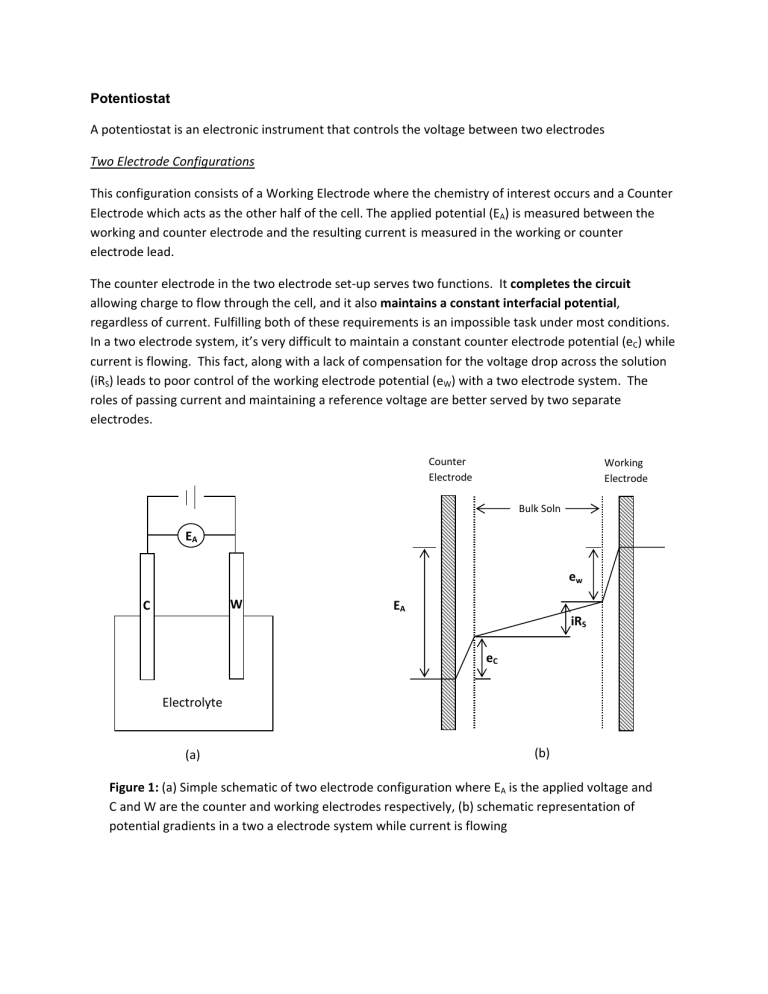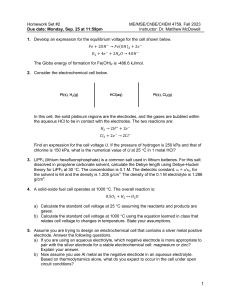
Potentiostat A potentiostat is an electronic instrument that controls the voltage between two electrodes Two Electrode Configurations This configuration consists of a Working Electrode where the chemistry of interest occurs and a Counter Electrode which acts as the other half of the cell. The applied potential (EA) is measured between the working and counter electrode and the resulting current is measured in the working or counter electrode lead. The counter electrode in the two electrode set‐up serves two functions. It completes the circuit allowing charge to flow through the cell, and it also maintains a constant interfacial potential, regardless of current. Fulfilling both of these requirements is an impossible task under most conditions. In a two electrode system, it’s very difficult to maintain a constant counter electrode potential (eC) while current is flowing. This fact, along with a lack of compensation for the voltage drop across the solution (iRS) leads to poor control of the working electrode potential (eW) with a two electrode system. The roles of passing current and maintaining a reference voltage are better served by two separate electrodes. Counter Electrode Working Electrode Bulk Soln EA ew W C EA iRS eC Electrolyte (a) (b) Figure 1: (a) Simple schematic of two electrode configuration where EA is the applied voltage and C and W are the counter and working electrodes respectively, (b) schematic representation of potential gradients in a two a electrode system while current is flowing Three Electrode Configuration The three electrode system remedies many of the issues of the two electrode configuration. The three electrode system consists of a working electrode, counter electrode, and reference electrode. The reference electrode’s role is to act as a reference in measuring and controlling the working electrode potential, without passing any current. The reference electrode should have a constant electrochemical potential at low current density. Additionally, since the reference electrode passes negligible current, the iR drop between the reference and working electrode (iRU) is often very small. Thus with the three electrode system, the reference potential is much more stable, and there is compensation for iR drop across the solution. This translates into superior control over working electrode potential. The most common lab reference electrodes are the Saturated Calomel Electrode and the Ag/AgCl electrode. In the three electrode configuration, the only role of the counter electrode is to pass all the current needed to balance the current observed at the working electrode. The counter electrode will often swing to extreme potentials in order to accomplish this task. Counter Electrode A Working Electrode Bulk Soln EA ew EA= eW‐er C R W iRu iRC eC Electrolyte (a) (b) Figure 2: (a) Simple schematic of three electrode configuration where EA is the applied voltage and C, W, and R are the working and counter and reference electrodes respectively, (b) schematic representation of potential gradients in a three a electrode system while current is flowing Potentiostat Operation A basic potentiostat can be modeled as an electronic circuit consisting of four components: the electrometer, the I/E converter, the control amplifier, and the signal. The Electrometer The electrometer circuit measures the voltage difference between the working and the reference electrode. Its output serves two purposes: it acts as a feedback signal within the potentiostat, and I is the voltage signal that is measured and displayed to the user. An ideal electrometer has infinite impendence and zero current. In reality the reference electrode does pass a very small amount of current. Current through the reference electrode can change its potential, but this current is usually so close to zero that the change is negligible. The capacitance of the electrometer and the resistance of the reference electrode form an RC circuit. If the RC time constant is too large it can limit the effective bandwidth of the electrometer. The electrometer bandwidth must be higher than the bandwidth of all other components in the potentiostat. Figure 3: (a) Schematic representation of a three electrode controlled potential apparatus. X1 on an amplifier indicates it’s a unity gain amplifier The I/E Converter The current to voltage converter measures the cell current. The cell current is forced through a current measurement resistor, Rm . The resulting voltage across this resistor is a measure of cell current. During the course of an experiment, cell current can change by several orders of magnitude. Such a wide range of current cannot be accurately measured by a single resistor. Modern potentiostats have a number of Rm resistors and an “I/E autoranging” algorithm that selects the appropriate resistor and switches it into the I/E circuit under computer control. The bandwidth of the I/E converter depends strongly on its sensitivity. Unwanted capacitance in the I/E converter along with Rm forms an RC circuit. In order to measure small currents, Rm must be sufficiently large. This larger resistance, however, increases the RC time constant of the circuit limits the I/E bandwidth. For instance, no potentiostat can measure 10nA at 100 kHz. The Control Amplifier The control amplifier compares the measured cell voltage to the desired cell voltage and drives current into the cell to force these voltages to be the same. The control amplifier works on the principle of negative feedback. The measured voltage enters the amplifier in the negative or inverting input. Therefore a positive perturbation in the measured voltage creates a decrease in the control amplifier output, which counteracts the initial change. The control amplifier has a limited output capability, for the PARSTAT is 10 V and 200 mA. The Signal In modern potentiostats, the signal circuit is a computer controlled voltage source. Proper choice of number sequences allows the computer to generate constant voltages, voltage ramps and sine waves at the signal current output. Computer Controlled Instrumentation Most potentiostats now utilize a microprocessor for signal generation and data acquisition. Computers are very useful for generating complex voltage waveforms. These waveforms are first created as numerical arrays in memory, which are sent to a Digital to Analog converter. The DAC produces an analog voltage proportional to the digital numerical arrays. The analog voltage is then sent to the control amplifier of the potentiostat. Conversely, in data acquisition, the voltage responses from the electrometer and I/E converter are digitized into numerical arrays and recorded at fixed time intervals. The accuracy of the analog to digital conversion depends on the number of bits used for a given voltage signal. For instance if a measurement system digitizes a 0‐10 V input signal with 8 bit resolution, it transforms the voltage signal to a number in the range 0‐255 as shown in the binary conversion below 00000000 0∗2 0∗2 0∗2 0∗2 0∗2 0∗2 0∗2 0∗2 0 11111111 1∗2 1∗2 1∗2 1∗2 1∗2 1∗2 1∗2 1∗2 255 The above conversion shows that after digitization, a 0 to 10 V signal expressed as an 8‐bit array will have a resolution of 10/255 or 39.2mV D/A Converter A/D Converter A/D Converter Figure 4: Block diagram of typical computer controlled potentiostat system References Bard, Allen J. and Faulkner, Larry R. Electrochemical Methods: Fundamentals and Applications. John Wiley and Sons, New Jersey, 2001. Heineman, William R. and Kissinger, Peter T. Laboratory Techniques in Electroanalytical Chemistry. Dekker, New York, 1996. Gamry Instruments. Application Notes: Potentiostat Primer. < http://www.gamry.com/App_Notes‐ /Potentiostat_Primer.htm>




